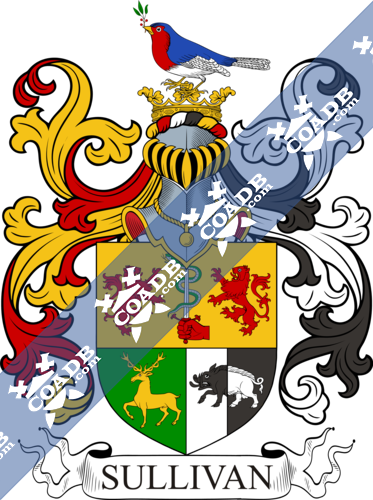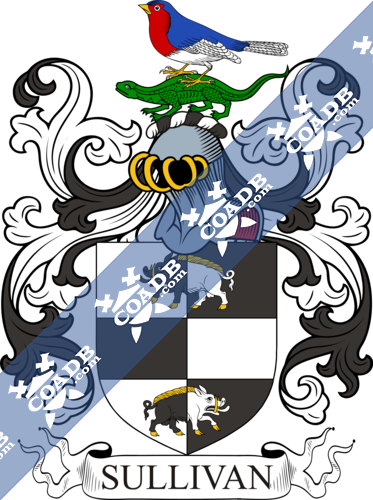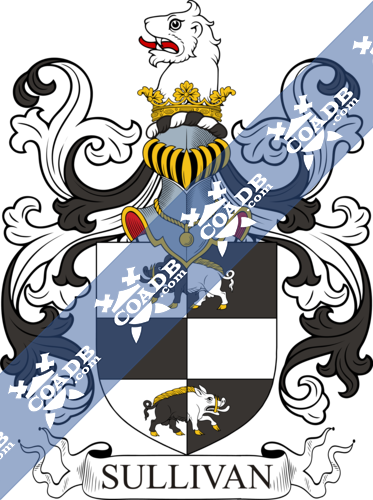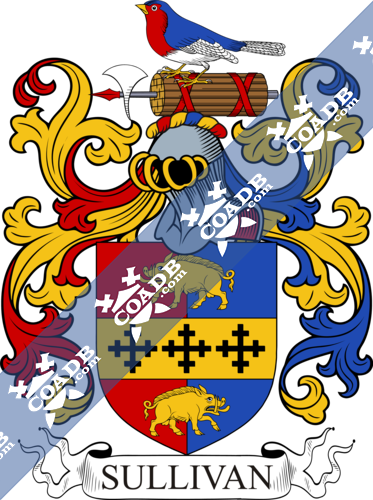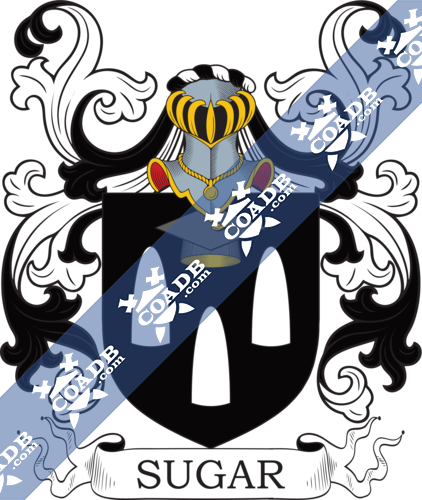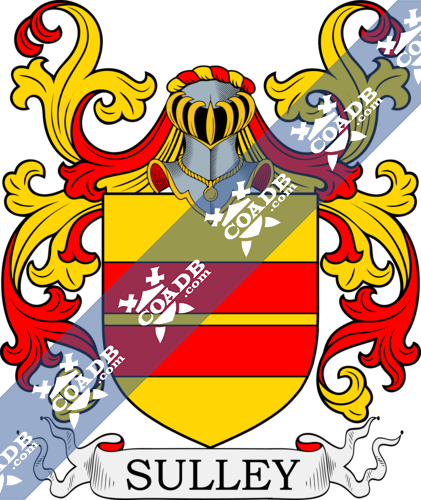Sullivan Family Crest, Coat of Arms and Name History

Sullivan Coat of Arms Gallery
Don’t know which Coat of Arms is yours?
We can do a genealogical research. Find out the exact history of your family!
Learn MoreSurname Meaning, Origin, and Etymology
Ireland is a country that has been the birth of place for some unique and special surnames with a rich history behind them. One of the most spread last names of this region is Sullivan, which is actually the Gaelic form derived from O Suileabhain, which it also derived from “suil” which means “eye”. The real etymological meaning of Sullivan is not completely certain, some claim that it means “hawk-eyed”, others say that it is “one-eyed” and a third possible meaning is “little dark-eyed one”. Another important aspect to consider is that the Gaelic prefix “O” means “male descendant of” or “grandson of” which means that in its original form, this surname expresses a familiar relationship between two members of a family, the total meaning would be something like “descendant of the hawk-eyed”.
This surname is connected to remarkable characters of the Irish history. The O Sullivan, or as they are better known today, Sullivan, are descendants of Eogham Mor, which son was Olioll Olum, the third King of Munster, an Irish province. O Sullivan was the widest spread last name in the province of Munster, more exactly in the territory of Cahir in the County of Tipperary in the south of Ireland during the 12th century. It was here where this family held their most ancient seat and then it spread across other counties such as Cork, Kerry, and Limerick. However, after the Norman Invasion of Ireland in 1169 and of Munster in 1180, this family had to leave their ancestral home in Tipperary to take went in separate ways. This divided the surname into its two principal branches, the O Sullivan Mór (Mór indicates that they were they larger group), which went to the south of the county Kerry and the O Sullivan Beare, who moved to the Beara Peninsula, to the west of the county Cork and the south of the county Kerry.
The first record of this surname belongs to Donald O Sullivan Bear, which was a military leader who was involved in several battles since the ends of 1590’s and participated in the Siege of the Dunboy Castle in 1602. The bearers of the surname O Sullivan eventually adopted the simpler form of Sullivan as their actual surname.
Spelling Variations
Spelling Variations were common during the middle era. Cases like Sullivan are good examples to explain why did this happen. The surname Sullivan had an evolution inside the borders of its original country, which it would naturally cause variations on its writing. Sullivan is not the original form of this last name, which means that at the moment of being exposed to other languages and translations, it had already experimented some changes. At the moment of being translated, it would go through some modifications to become part of the new language, like the English which assigned an apostrophe to the Irish surname.
Another typical reason that caused spelling variations on the last names that were original from the medieval age, was that the scribes used to write words according to their sound. This happened because of many languages didn’t have grammatical rules or a written format, so each scribe would write words differently. Thanks to all of this, some of the common spelling variations of Sullivan are Sullivan, O’Sullivan, O Sullivan, Sullavan, Sullivan, Sillivan, Silliphant and Sillifant.
Popularity & Geographic Distribution
According to the numbers provided by the census of 2014, Sullivan is not a current popular surname. It is the 1,521st most common surname in the planet with approximately 353,925 bearers. The country where it is most prevalent is in the United States and its highest density is in Ireland. The country with the second biggest amount of bearers of Sullivan is England, followed by Australia in third place.
Early Bearers of the Surname
Some old bearers of Sullivan appear in some records of different regions thanks to their actions during that time in that place, such as Owen Rua O’Sulieabhan (1748-1784) who was an important poet, Sir Arthur Sullivan (1842-1900) who was part of the Gilbert and Sullivan operas, Phillip O’Sullivan Beare (1590-1660) who was a soldier in the army of Spain and worked also as a historian, Colonel John O’Sullivan (1700-1760) a soldier from Ireland who served in the French Army, Francis Stoughton Sullivan (1715-1766) an Irish lawyer and Professor, John Sullivan (1788-1855) a British governor, Alexander Martin Sullivan (1830-1884) an Irish politician and Timothy Daniel Sullivan (1827-1914) an Irish nationalist and journalist.
History, Genealogy, and Ancestry
There are very good records that allow examining the genealogical trees of some branches of the surname Sullivan. One of them is the Sullivan of Tullylease who actually are connected to Oliol Ollum the third King of Munster himself. This family was represented by Reverend John Sullivan of Tullylease House on Cork, who was born on November 1, 1638, and got married to Georgina Cox, daughter of John Cox, Esquire, and J.P. of Weston-super-Mare, Somerset on June 5, 1877. They had one daughter, Mary Georgina Sullivan.
The previews form of Sullivan was O Sullivan which comes from Oliol Ollum, King of Muster who according to the Iberian Chronicles could be traced from Heber Fionn, a son of Milesius. His descendants were Daniel O Sullivan who took off the prefix O from his surname. He got married to Margaret Tucker of the County Kerry and died in 1682. Daniel died but not without leaving a child, Darby Sullivan, Esquire by his wife Joanna Taylor of Kilbolane Castle. They had a son and then Darby died, their son was John Sullivan, who got married to Mary Herne of Hernes-Brook in 1714 and then died in 1737.
The children of John Sullivan and Mary Herne were: Jerome who was born on November 8, 1716, and got married to Ann Russel of Dublin and with her had two daughters, Elizabeth and Mary and also a son, Maurice Sullivan, who was born on April 9, 1757. The second son of John and Mary was William Sullivan, who will be explained after his brothers and sisters. The third son was James, who was born on June 14, 1731, and got married to Margaret Conor, daughter of Mark Conor, Esquire of Ballyire on March 1, 1764.
The children of James and Margaret were: John, who was born in 1765 and got married to Eliza Knight, daughter of Christopher Knight. The offspring of John and Eliza were James, who became a Lieutenant on the 83rd regiment, Peppar Knight who died without children, Margaret who got married to Edward Rae and Susan who got married to John Parker. The second son of James and Margaret was James Chesterfield of Limerick, he became a Major of the 83rd regiment and J.P. He was born on October 9, 1778, and got married to Mary Anne Ashe, the first daughter of Rev. William Ashe, Prebendary and Rector of Croagh on September 2, 1812.
The children of James Chesterfield and Mary Anne Ashe were: William, who died on December of 1832, Henry White who died on June 2, 1848, James Incumbent of Askeaton who was born in 1818 and got married to Georgina Lucie, daughter of George Annesley Owen, Esquire of Ramsgate on July 23, 1856. The offspring of James Incumbent and Georgina Lucie were John, Edward who became a Lieutenant in the Army, Thomas, Jefferies, Eliza, Marion, who got married to Major Charles Parker on August 14, 1855, Margaret, Fanny, Harriette who got married to Charles J. Ellis a Colonel of the Royal Marines and son of Capt. Ellis on November 18, 1852.
The rest of the children of James and Margaret Conor were William, who grew up to become a Captain in the 30th Regiment, was born in 1781 and died without children in 1827, Margaret who got married to John Wall, Eliza who got married to Roger Adams, Esquire of Rock Abbey in the County of Cork and Mary who got married to Thomas Green, Esquire of Air Hill in the County of Cork. The children of this last marriage were James, Barrister-at-Law, Susan who got married to William Sullivan, Esquire of Tullylease House, Eliza, and Ann.
Now back to William Sullivan, the second child of John Sullivan and Mary Herne. He was born on September 29, 1729, and got married to Mary Morgell, daughter of Thomas Morgell, Esquire and J.P. of Mount Morgell in Limerick County on February 15, 1763. Their children were John, the heir, Robert, who was born on October 5, 1767, Thomas Morgell who was born on May 11, 1771 and got married to Miss Blennerhasseu, Jeremiah who was born on August 15, 1773 and Melina who got married to George Morgan, Esquire of Old Abbey, County of Limerick in 1879. William Sullivan died on February 23, 1795.
The heir of William was his first son, John Sullivan, now Esquire of Tullylease House. He was born on June 19, 1764 and got married to Anne Costley, sister of General Costley on July 10, 1794. Their children were William of Tullylease House, John, James who got married to Marion Beresford. The children of this last marriage were Beresford who was born on March, 1837, Arthur Bunbury who was born in 1840, James John who was born in 1848, Jane Bunbury Marion Beresforld who got married to William White on April 22, 1869, Susan Wilhelmina who got married to Rev. Joseph Barton on September 11, 1867 and Thomas.
The following child of John Sullivan and Anne Costley was Jeremiah John of Great Grimsby in the County of Lincoln. He was born on July 9, 1815 and got married to Anne Duncuft, daughter of James Ogden, Esquire of Hollinwood, near Manchester on May 6, 1846. Jeremiah John and Anne had the following children Charles Edward who was born on April 7, 1847 and grew up to become a Reverend, Alfredo who died while still being a child, Frederick who was born on March 24, 1850 and Eliza Anne.
The next child of John Sullivan and Anne Costley was Charles Costley who got married to Belinda Tomkins, daughter of Major Tomkins, they only had one daughter named Annie. Then there was Melian, who got married to Jeremiah Sullivan and had a son, John of Curramore, County of Limerick. Caroline, who got married R.R. White and their children were Robert, John Annie, Melian, and Caroline. Mary, who got married to M.J. Mason, Esquire of Glenbrook in the County of Cork, and their children were John, Edward, Anne, Melian, and Kate. Eliza who got married to man with the surname Dooley, and they had two daughters, Annie and Emma Bridge O’Callaghan.
John Sullivan died on March 30, 1836, and was succeeded by his first son, William Sullivan, now Esquire and J.P. of Tullylease House. He was born on April 15, 1807, and got married to Susan Green, daughter of Tomas Green, Esquire of Air Hill, county of Cork and their children were John, now of Tullylease House, James William who was born in 1581, Maria Eliza and Elizabeth Adams. William Sullivan died on December 28, 1871.
The coat of arms of this family consisted in a fess, a pale base in chief or a dexter hand couped at the wrist grasping a sword with a silver blade entwined with a serpent between two rampant lions looking to each other, the base vert charged with a buck. The crest on a ducal coronet or a robin in the beak of a sprig of laurel. Their Motto was “Lamh foistenach an nachtar”.
Another branch of this surname was the Sullivan of Curramore who was represented by John Jeremiah Sullivan, Esquire of Curramore in the county of Limerick, and also of Warberry Court in Devon. He was born on May 1825. He got married a first time to Isabel Harrison, daughter of Richard Harrison, Esquire of Wyton Hall, in the county of York. Their children were Herbert who was born on October 22, 1852, Algernon who was born on May 1, 1854, and died in 1866, John Ernest Holt who was born in 1856 and grew up to be a Lieutenant in the 73rd Regiment, Adela, and Beatrice Isabel.
John Jeremiah Sullivan got married again to Caroline Harriet Taylor, daughter of the Reverend John Fletcher, Rector of Quedgeley, county of Gloucester, on June 4, 1867. The lineage of this family started with Jeremiah Sullivan who got married to Ann Costley and then died on June 1825. They had only one son, John Jeremiah Sullivan, now Esquire of Curramore. The coat of arms, crest, and motto are the same as the Sullivan of Tullylease House, who were explained above.
Early American and New World Settlers
Once the Europeans found out about the existence of America, they opened new commercial routes and established several communities of people from the old continent who come to America. This happened because a lot of people decided to travel from Europe to the new continent to start a new life and being part of the exploration of the new territories. They brought their way of life, their cultures, and their last names, so they began to be used in these new lands.
Bearers of the surname Sullivan decided to do this travel, and some of them who arrived in the United States during the 17th century were Jael Sullivan, who arrived in Massachusetts in 1654, Onoris Sullivan who arrived in Virginia in 1656, two years later Teage Sullivan landed in Maryland, Florence Sullivan landed in South Carolina in 1669 and Jeremy Sullivan arrived in Maryland in 1670.
During the 18th century the arrival of bearers of Sullivan continued with Alice Sullivan, who arrived in Virginia in 1715, Joan Sullivan who landed in Pennsylvania in 1745, Austis Sullivan also arrived in Pennsylvania in 1746, and in that same year Honour Sullivan also landed in Pennsylvania and David Sullivan arrived in Boston, Massachusetts in 1765. Others bearers of Sullivan choose Canada as their destiny, some of them were Thomas Sullivan, who landed in Quebec in 1803, John Sullivan who arrived in Nova Scotia in 1808, another John Sullivan who landed in that same place but in 1813, Patrick Sullivan who also arrived in Nova Scotia in 1813 and James Sullivan who landed in Canada in 1819.
Mottoes
Mottoes were used by families to express their opinion about a fundamental aspect of their life, such as religion or politics. It could also work to communicate the base of their code of conduct or to whom they were loyal. This phrases would have the additional function of distinguishing some families because they worked to identify a specific branch from a group of families with the same surname. In the case of the surname Sullivan, we were able to find 4 mottoes from different family lines. The first one is “Lamh foistenach abu” which can be translated as “The open hand defying”, the second one was “Lamh foisdineach an nachter” which in English means “What gain by conquest we secure by clemency”, this was the motto used by the Sullivan of Tullylease House in Wales. The next motto is “Nec timeo nec sperno” which can be translated into English as “Nor do I fear nor spurn” and the fourth motto is “Tot premia vitae” which can be translated as “So many of live premium”.
Grantees
We were unable to locate any documented grantees for the Sullivan family
Notables
Some bearers of the surname Sullivan have played key roles in different areas and their names are synonyms of great improvement in those areas. Some of the most famous bearers of Sullivan are Cory Sullivan (b. 1979) an American professional baseball player which last appearance was with the Houston Astros, Grant Sullivan (1924-2011) an American actor, Maxine Sullivan (1911-1987) an American jazz singer, Susan Sullivan (b. 1942) an American actress, Steve Sullivan (b. 1974) a Canadian professional ice hockey player and was part of the national team of Canada, Kate Sullivan (b. 1976) an American television news anchor, Patrick Sullivan (b. 1950) an American football player who earned the Heisman Trophy in 1971, Dennis Parnell Sullivan (b. 1941) an American mathematician, Andrew Michael Sullivan (1963) an English-American author, editor and blogger, Charles L. Sullivan (1924-1979) an American politician, attorney and military pilot and Christopher Daniel Sullivan (1870-1942) an American politician who was an US Representative from New York from 1917-1941.
Blazons & Genealogy Notes
1) (a Sept who originally possessed a territory in the co. Tipperary, but were driven out by the De Burghus, and settled in cos. Cork and Kerry; the name is derived from Suilleabhan, a Chieftain who flourished A.D. 950). Per fess the base per pale in chief or, a dexter hand couped at the wrist grasping a sword erect, pommel and hilt gu., the blade entwined with a serpent ppr. betw. two lions ramp. respecting each other of the second on the dexter base vert a stag trippant gold, on the sinister base per pale ar. and sa. a boar pass, counterchanged.
2) O’Sullivan Mor – (the Chief of the senior line of the Sept was known as O’Sullivan Mor). Same Arms. Crest—On a ducal coronet or, a robin redbreast holding in the beak a sprig of laurel all ppr. Motto—Lamh foistenach abu (the open hand defying).
3) O’Sullivan Beare – (the second branch of the Sept, settled at Bearra, co. Cork, now Bearhaven; their Chieftain was known as O’Sullivan Beare). Per pale sa. and ar. a fess betw. in chief a boar pass, and in base another counter pass. all counterchanged, armed, hoofed, and bristled or. Crest—On a lizard vert a robin redbreast ppr.
4) O’Sullivan – (Dunkerron, co. Kerry; Impalement Fun. Ent. Ulster’s Office, 1639. John O’Connob, Esq., of Carrigfoyle, in same co., whose wife was Sheely O’Sullivan, dau. of Owen O’Sullivan, of Dunkerron). Same Arms. Crest—Out a ducal coronet or, a lion’s head ar. langued gu. Motto—Nec timeo nec sperno.
5) (Thames Ditton, co. Surrey, bart.). Per fess, the base per pale, in chief or, a dexter hand couped at the wrist, grasping a sword erect, pommel and hilt gu. the blade entwined with a serpent ppr. betw. two lions ramp. respecting each other of the second; the dexter base vert, charged with a buck trippant or, on the sinister base per pale ar. and sa. a boar pass, counterchanged. Crest—On a ducal coronet or, a robin, in the beak a sprig of laurel ppr. Motto—Lamh foisdineach an nachter; i.e., What we gain by conquest we secure by clemency.
6) (Garryduff, co. Cork, Bart.; Right Hon. Sir Edward Sullivan, LL.D., Lord Chancellor of Ireland, 1884, Master of the Rolls in Ireland, 1870 to 1884. and M.P. for Mallow, 1865 to 1870; was created a Baronet, 29 Dec. 1881). Per pale gu. and az. on a fesse betw. in chief a boar pass. and in base another boar counter-pass. or. three cross crosslets sa. Crest—The Roman fasces fessewise ppr. banded gu. thereon a robin redbreast also ppr. Motto—Tot premia vitae.

